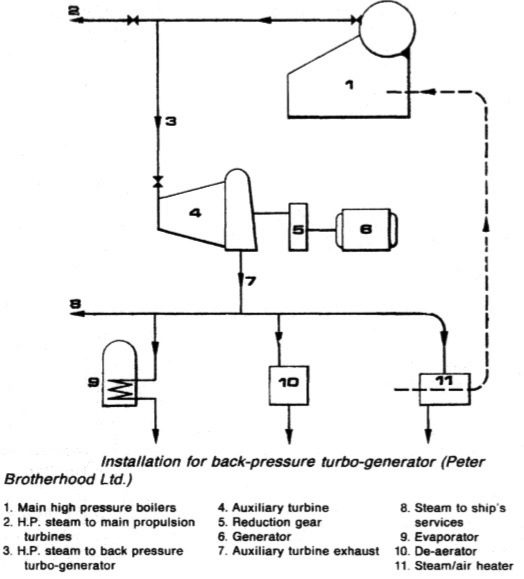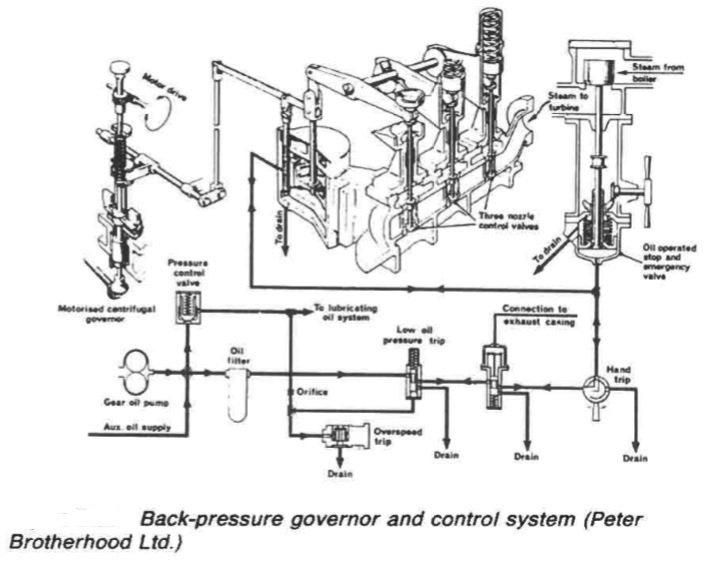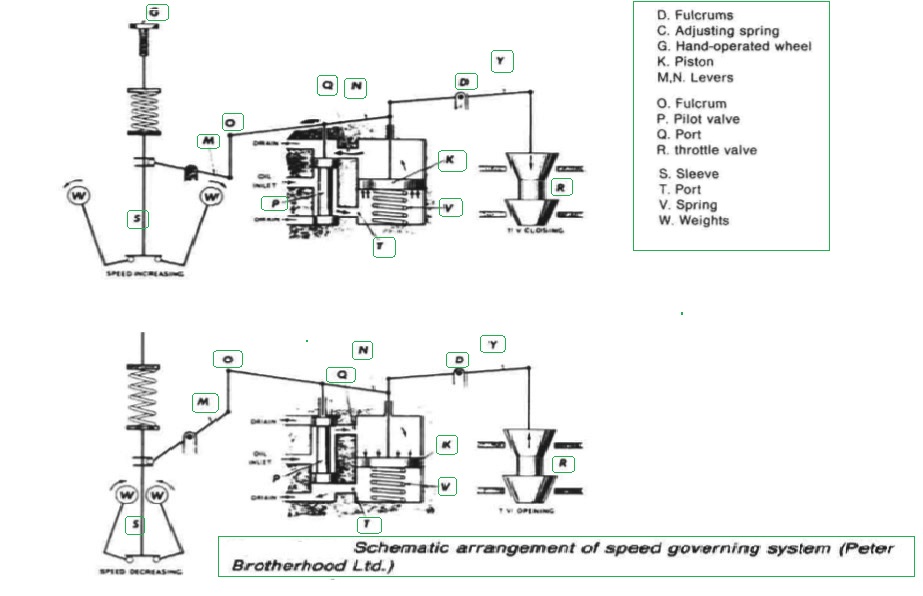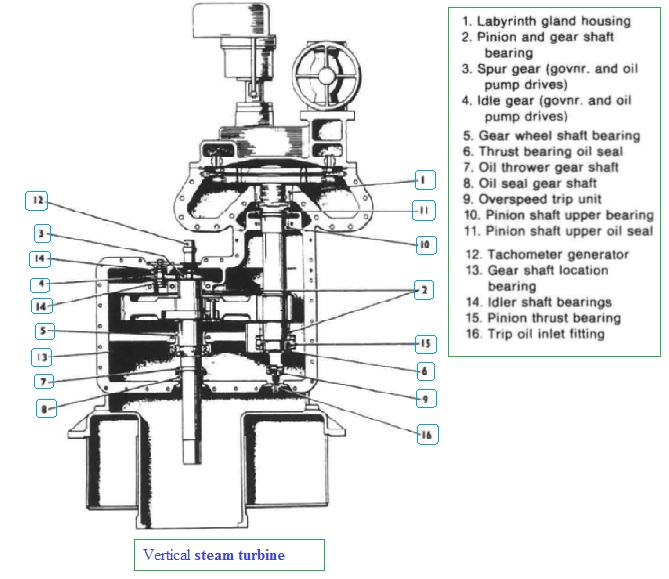
Home page||Auxiliary Power ||
Marine auxiliary engine-Back pressure turbines, trips and vertical steam turbines
Back-pressure turbines:
Many ships have used an auxiliary steam turbine as a primary pressure reducing stage before passing the steam to other auxiliaries demanding steam at a substantially lower pressure than that available. Such an arrangement (Figure 1) gives a heat balance which is far more favourable than that obtained with a pressure reducing valve.
Back pressure turbines have most of the features of a condensing turbine but no condenser. The most important difference is in the governing. Designed to work against back pressures in the range 1—3.5 bar and with much lower available heat drops than with a condensing turbine, governing by the simple opening or closing of the throttle valve is inadequate. Instead the governor (Figure 2) sequentially controls the opening of a number of nozzle contr valves.
The control system is arranged for a straight line regulated (load/speed) with a speed droop of about 4% between full load and no loa The turbine governor also incorporates speed droop control adjustment with range of approximately 2.5% to 5.5% to enable load sharing between a grot of generators to be readily adjusted.

Figure 1: Installation for back-pressure turbo-generator (Peter Brotherhood Ltd.)
1, Main high pressure boilers 4. Auxiliary turbine 8. Steam to ship's 2, HP. steam to main propulsion 5. Reduction gear services turbines 6. Generator 9. Evaporator 3, H.P. steam to back pressure 7. Auxiliary turbine exhaust 10, De-aerator turbo-generator 11. Steam/air heater

Figure 2: Back-pressure governor and control system (Peter Brotherhood Ltd.)
Back-pressure trip
The purpose of the back-pressure trip is to protect the turbine and exhaust system in the event of over-pressure due to loss of condenser cooling water, extraction pump failure or accidental closure of the exhaust valve.
The trip consists of a spring loaded bellows, connected to a hydraulic spool valve interposed in the governing oil circuit between the main oil pump and the governor relay. When the turbine is running the valve is held upwards by the spring. In this position high pressure oil can pass freely across the upper ports of the valve to actuate the governor relay.
If the back pressure increases to a predetermined level the load on the bellows unit is sufficient to overcome the adjusting spring and allow the operating spindle to move downwards and push the ball valve off its seat. In so doing, oil at relay pressure is admitted through the drilled passages in the trip body to the piston valve, so depressing the valve against its spring. The valve will, simultaneously, cut off and drain the high pressure supply to the governor relay. The throttle valve is consequently closed by the relay pistons under the action of the spring V (Figure 3) and the turbine is stopped.

Figure 3: Schematic arrangement of speed governing system
Vertical steam turbines
Vertical steam turbines are extensively used for cargo, ballast and other pundrives. Like the horizontal machines used for power generation they can 1: condensing or back-pressure units. They are, however, invariably single staŁ machines having an overhung wheel (Figure 4). The steam casing of th turbine is a simple steel casting bolted to the top of the exhaust casing. The nozzles are fitted and seal welded into the underside of the steam casing inL belt forming a ring which provides an uninterrupted arc of admission. The exhaust casing is split in the vertical plane, allowing removal of the front ha for rotor inspection without disturbing the steam or exhaust piping.
The rotor shaft is bolted to a head flange on the pinion shaft of the sing reduction gearing. A thrust bearing located below the pinion supports the weight of the rotor and absorbs any vertical thrust. This bearing is usually the Michell multi-pad type.

Figure 4: Sectional arrangement of vertical turbine (Peter Brotherhood Ltd.)
1. Labyrinth gland housing 5. Gear wheel shaft bearing 12, Tachometer generator 2. Pinion and gear shaft 6, Thrust bearing oil seal 13. Gear shaft location bearing 7. Oil thrower gear shaft bearing 3. Spur gear (govnr. and oil 8. Oil seal gear shaft 14, Idler shaft bearings pump drives) 9. Overspeed trip unit 15. Pinion thrust bearing 4. Idle gear (govnr. and oil 10, Pinion shaft upper bearing 16. Trip oil inlet fitting pump drives) 11. Pinion shaft upper oil seal
Summarized below some of the basic procedure of marine auxiliary machinery :
- Auxiliary engine general construction
Major problems have been experienced on large slow-speed
engines with some of the poor quality bunkers such as those containing
catalytic fines. Fuel should conform to the specification given in the instruction
book for the engine.
......
- Auxiliary engine back pressure turbine
Many ships have used an auxiliary steam turbine as a primary pressure reducing stage before passing the steam to other auxiliaries demanding steam at a substantially lower pressure than that available. Such an arrangement gives a heat balance which is far more favourable than that obtained with a pressure reducing valve......
- Auxiliary engine fuel pump
The most common fuel pump used on auxiliary diesel engines is the Bosch
type. This is a cam operated jerk pump with a helical groove on the plunger to
control the fuel cut-off and therefore the quantity of fuel delivered to the
cylinder for combustion.
......
- Auxiliary engine common fuel injector
Fuel is delivered to an annular space in the nozzle via a hole, drilled through
the nozzle body from the inlet. The nozzle valve is forced from its seat in the
nozzle body by the pressure of fuel from the pump, acting on the shoulder of
the needle valve.
......
- Auxiliary engine cooling system
A variety of cooling systems may be adopted for marine auxiliary engines but
the most commonly used is the simple closed circuit system . Sea
water is passed through the intercooler, the oil cooler and then the jacket water
cooler in series flow.
......
- Auxiliary engine hydraulic governor
When used for alternating current power generation, a diesel engine is normally fitted with a hydraulic governor. This incorporates a centrifugal speed sensing device (spring loaded flyweights) controlling a suitably damped oil operated servo-cylinder through a pilot valve.
......
- Auxiliary engine speed governing system
Unlike propulsion turbines, generator turbines work at constant speed and must be governed accordingly. Classification Society rules require that there must be only a 10% momentary and a 6% permanent variation in speed when full load is suddenly taken off or put on.
......
- Auxiliary engine tracing faults
The failure of an engine to start or problems while running may be traced to
faults with the fuel injection system or other possible causes. Instruction
manual guidance on fault finding and remedies will include some of the typical
problems
......
- Generators driven from the main propulsion
Generators can variously be driven from the propeller shaft, through a gearbox or by being mounted on the engine itself.
......
- Exhaust gas boilers
The original exhaust gas boilers or economizers were of simple construction and produced, from the low powered engines of the time, a very moderate amount of steam. As large slow speed engine powers increased, the larger quantity of steam that could be generated from otherwise wasted exhaust energy,
......
- Auxiliary engine Turbo generator construction
Turbo-generator construction-For electrical power generation, turbines are conventionally horizontal axial flow machines of the impulse reaction type. They may exhaust either to an integral condenser (invariably underslung) or to a separate central auxiliary condenser or the ship's main condenser.
......
- Caterpillar engine fuel system
The range of larger Caterpillar engines use helix-type fuel pumps driven from a
separate camshaft.......
Home page||Cooling ||Machinery||Services ||Valves ||Pumps ||Auxiliary Power ||Propeller shaft ||Steering gears ||Ship stabilizers||Refrigeration||Air conditioning ||Deck machinery||Fire protection||Ship design
||Home ||
General Cargo Ship.com provide information on cargo ships various machinery systems -handling procedures, on board safety measures and some basic knowledge of cargo ships that might be useful for people working on board and those who working in the terminal. For any remarks please
Contact us
Copyright © 2010-2016 General Cargo Ship.com All rights reserved.
Terms and conditions of use
Read our privacy policy|| Home page||



